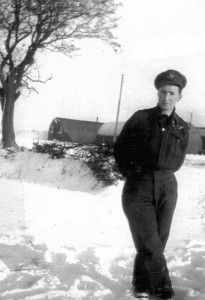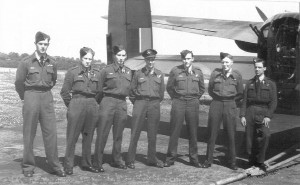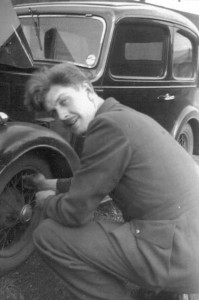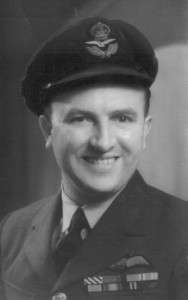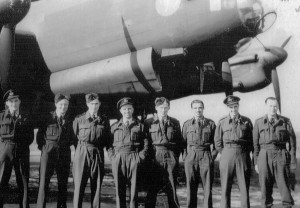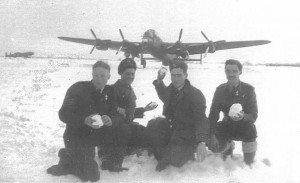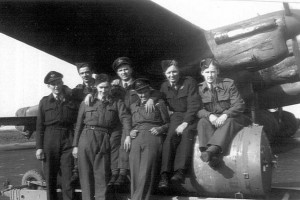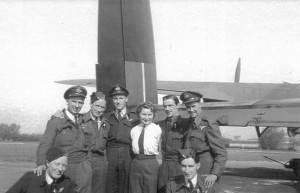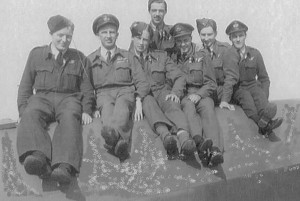During our research all of us who have been involved in working on the LM658 story had managed to overlook the obvious with regards to Flt Lt Christopher Holland who, on the night of 12th August 1944 had sat in the cockpit of LM658 alongside skipper Bill Paston-Williams to do his “second dickie” (operational familiarisation trip) to gain first hand experience of night op’s over Germany, which implied that that Flt Lt Holland was already the skipper of an operationally ready crew who would of course be eagerly awaiting his return and a briefing as to what lay ahead on their first night trip.
Our oversight came to light when the family of Flying Officer James H Boyle RCAF (retired) of Calgary, Canada found the LM658 website during research and made contact with us. Mr Boyle who is indeed still alive and well was the navigator with Flt Lt Holland’s own crew and was eager to make contact with us to discover at last the fate of his friend and the aircraft on which he had been lost.
Mr Boyle was especially happy to be put in touch with an equally thrilled Mrs Joanna Newton who is now in correspondence with her brother’s friend and comrade!
The Memoirs of Flying Officer James H Boyle (RCAF retired):
I thought I should give you a little background about the RCAF in which I served from my enlistment on July 20th 1942 until my discharge on August 8th 1945. During the 1939-1945 war the RCAF formed part of the British Commonwealth Air Training Plan (BCATP) which was set up in December 1939 between Canada, the UK, Australia and New Zealand, with Canada being its focus. Canada had an abundance of air training space beyond the range of enemy aircraft, plus excellent climatic conditions for flying and its relative close proximity to the UK via the North Atlantic shipping lanes. The program cost the Canadian government more than 1.6 billion dollars, which was about three quarters of the total cost. This vast program graduated over 131000 aircrew, (pilots, navigators, bomb aimers, wireless operators, air gunners and flight engineers), from the 4 founding partners, and other parts of the commonwealth, of which about 73000 were Canadian. Of the 250000 men and women in the wartime RCAF, 94000 served overseas. The program also exacted a very heavy toll in Canadian casualties.
I first met Christopher Holland when I was selected for possible aircrew training and was posted to ITS (Initial Training School). We arrived at 30 OTU (Operation Training Unit) in Seighford Staffordshire on Feb 15, 1944 and finished in the middle of May 1944 during which we completed 32 short training flights in Wellington twin engine bomber aircraft nicknamed “Wimpeys.” These had been used by the RAF on their main bomber activities, but were being replaced by Halifax and Lancaster aircraft. The Wellington had a wingspan of 86 feet and had two Bristol Hercules engines and a power operated turret in the rear with four Browning machine guns and a two gun turret in the front which was manned by the bomb aimer.
While at OTU we did many circuit and landings, single engine emergency flying, lots of practice bombing runs and plenty of navigational practice flights of roughly 5 hours each and we even did a leaflet raid on a target in Europe!
I graduated as a Navigator under the British Commonwealth Air Training Plan. I flew a total of 29 flights on twin engine Wellington bombers at 30 OTU with F/L Chris Holland as pilot. Then on June 28th 1944 we were both posted to 1656 HCU (Heavy Conversion Unit) at Lindholme where we spent 31 hours flying, converting from Wellington to Halifax four engined bombers doing a further 12 flights with Chris as pilot and I as navigator. Next on July 20th 1944 we were posted to 1 L.F.S.(Lancaster Finishing School) at Hemswell, Lincolnshire where we converted to Lancaster Heavy Bombers. Some flights lasted 50 minutes, several were cross country trips of approx 5 hours duration and one lasted over 6 hours. The second course involved 12 flights on 4 engine Halifax Aircraft, the third course required 7 trips on Lancasters. Here we also got the seventh and final member of the crew, our flight engineer Sergeant Charlie Taylor, so we now had a full crew, 2 Canadians, 2 Australians, and 3 English.
Having passed these three courses Chris and I were posted to 100 Squadron. Now I mentioned Chris and I had these three courses, but our wonderful crew also came along to ensure we did everything right and got safely home. As a matter of interest I flew as the navigator for Flight Lieutenant Holland for a total of 163 hours of which 80 hours were flown at night and 83 hours in the daylight. I think he only got upset with me once!
I was given training on two very new electronic navigational aids, which we hadn’t even heard of before. One was called a “Gee Box”.This was similar to a miniature TV screen. It came with 3 or 4 interchangeable modules, each of which was designed to pick up electronic signals from 2 or 3 transmitting stations in the UK and in parts of France and Holland, which had been rescued from the Germans.The aircraft’s ground position would show on the TV monitor at the intersection of 2 or more of these radar signals. These were “blips” about a half inch in height. When we were able to get two separate intersecting “blips” on the monitor we could plot this on our navigation chart and determine our ground position. The Navigation chart recorded every compass course and each change of course and the airspeed, so we had the ability to determine our air position (dead reckoning). When we obtained a ground position we could then calculate what direction the wind was blowing and the wind speed! The only problem with the GEE box was that the Germans learned about this little box and soon discovered how to render it ineffective simply by the introduction of “ghost blips” that often filled the entire monitor with what we called “grass” which made it impossible to pick out the two BLIPS needed to determine our ground position in the air. I mentioned the Gee box had 3 or 4 interchangeable modules. From time to time when none of the modules were producing the anticipated signals, occasionally a good firm kick would do the trick! (Not included in the instruction manual!!!)
The other Navigational aid was called H2S. Each aircraft had a scanner on the belly of the aircraft which sent signals to the ground and as these bounced back, they were picked up on an electronic tube on the Navigator’s table. Water would not reflect as much as the ground did, so we could see the coast line very clear, built up areas such as large cities showed up as bright blobs.
At the time our crew consisted of :
- Chris Holland (Pilot),
- Jim Boyle (Navigator)
- Charlie Taylor (Flight Engineer)
- Don Balser (Bomb Aimer)
- Ted Clarke (Wireless Operator)
- Jack Thornton (Tail Gunner)
- Ken Hill (Mid Upper Gunner).
At 100 Squadron we completed four daytime missions to targets in France and then on the night of the 12 August 1944 our pilot, Chris Holland was required to accompany another crew from 100 Squadron (HW-W LM658) on a night-time familiarization flight to a target in Germany. The object of this exercise was for Chris Holland to experience what it was like at the target in the way of flak and search lights. Unfortunately on this trip their whole crew along with “our Chris” went missing, their aircraft was shot down and what a shock it was, as we personally knew the crew members with whom Chris was flying on the night they did not return from the mission!! Our crew was now without a Pilot.
We had to put this tragedy behind us and go in search of a new Captain (Pilot). To do so, we had to report in September 1944 to the H.C.U. at Lindholme, Yorkshire which we had attended in July 1944, to see if we could “hook-up” with a Captain (pilot). We were fortunate, as we met Stevie (F/L Stevens) who was a bit older than “our Chris” and had completed a tour of ops in North Africa where he earned the D.F.M.
The DFM was awarded to non-commissioned personnel; if an officer receives this award he gets a D.F.C. (the Distinguished Flying Cross)
After spending two weeks at 1662 HCU we went back to 1 LFS so Stevie could become familiar with flying a Lancaster. We were then posted to 625 Squadron on October 12, 1944 and did our fifth “Op” flight on Oct 30, 1944 at Cologne Germany. At 625 Squadron our regular Lancaster was CF-D2 or Dog 2 as we knew her!
As a crew with F/L Stevens, we had a number of rather interesting flights.
- In September 1944, we were at the HCU, on a routine training flight. The propeller on one of the port engines flew off and on its flight it hit one of the propellers on the starboard side splintering it all to hell! On the Halifax aircraft, the Navigator is positioned in the nose of the aircraft right below where the Pilot and Engineer are positioned. I was lucky the loose propeller didn’t come into my space. After this accident I lost all interest in flying in Halifax aircraft and was glad our remaining trips were all conducted in Lancasters (a great aircraft!!). Our pilot Stevie with only 2 engines operating had no trouble bringing the plane back to our base.
- The second interesting flight was an operational flight in January 1945 to Merseberg near Leipzig in Germany – an 8 hour trip at night. After completing the bombing run and on our way home, our tail gunner spotted an unfriendly fighter aircraft on our tail. Our pilot started evasive action, swinging our Dog 2 Lancaster up and down and left and right. Every thing loose in the aircraft was flying around, but our sharp eyed rear gunner managed to get the German Jet Fighter in his sights and shot it down! When we got flying straight and level again I had to work my way to the tail of the aircraft to reset the gyro compass which had toppled during the manoeuvres that Stevie had put the aircraft through. When we got back to base the Squadron officials didn’t believe us, as there had not been any previous sightings of German Jet Fighter Aircraft at night. However several weeks later, our account of shooting down a Jet Fighter was confirmed. Stevie was awarded a DFC and Thornie a DFM for spotting this jet fighter aircraft and for shooting it down.
- Our Flight Engineer recounted one of our operational flights that scared the dickens out of him: On the last leg to the target area, we were running behind our E.T.A. The meteorological reports on the anticipated wind and wind direction were way off the actual wind conditions. On the way to the target our navigational equipment was also “U.S”. The Gee Box was full of grass. So I was unable to fix our ground position, and our H2S was inoperative. We were flying under clouds so we couldn’t use astral navigation. All we had was “dead reckoning”. As a result we were a good 20 to 30 minutes late over the target, and all alone. The enemy crew manning the search lights was trying to get us into a “cone” and the flak was flying all around us. Thankfully the enemy couldn’t get a fix on us and we managed to drop our load of bombs on the target which was already well lit up by the bombs dropped by the aircraft ahead of us and got the dickens out of there in a hurry!!!
- On another trip the flight engineer hit the wrong button when he went to connect the starboard fuel tanks to the fuel lines going to the engines, replacing the fuel from the port tanks which were “on empty”. When one of the engines sputtered, he realized his mistake and got the right switch to supply fuel from the starboard tanks to all four engines. Lucky for us, as we wouldn’t have made it back to base with the then nearly empty tanks on the port side!!
We remained at 625 Squadron until April 5th 1945 when we were moved to 576 Squadron at Fiskerton near Lincoln, where we finished our tour with 2 more operations, one on the 9th of April and the other on the 18th of April.
I am told all that is left of Fiskerton Airdrome is a cairn with this inscription:
“This stone and tree are sited on the airfield, in memory of those who served here during World War Two”.
Another tribute to Airmen and Air Women was written by an RAF veteran who had flown on a number of the ‘ops” we were on. He wrote the following:
“What would the next generation know about the end of a tour? When the crew were tired, edgy, wondering if they could cross the finish line of the marathon? They had endured almost too many succeeding nights of flak, getting coned over the target by the dreaded searchlights. On the long way home, it was hard to relax with night fighter aircraft swarming along in the stream of Bombers, like sharks, looking for prey at 15,000 – 20,000 feet.”
After the fall of France in June 1940 the BCATP was accelerated by the integration of all British Units in Canada in the BCATP. At the plans peak there were 107 schools, and 184 ancillary units at 231 sites. Aircraft numbered 10900 and the ground organization at 104,100 men and women. Canadian graduates numbered 72800, providing crews for 40 RCAF home Defence Units and 45 overseas RCAF squadrons, plus about 25% of the total strength of all the RAF Squadrons.
After completing our tour on April 18th 1945 we went on leave. We were in England on VE day and as we had volunteered for the Far East war we were posted back to Canada. I returned on a small troop ship named the “Scythia”. We were provided with individual state rooms, much nicer than the accommodation we had going to England. The weather was wonderful, the seas were calm and we arrived in Canada a short time before VJ day. As the war had ended I obtained my discharge on Aug 8, 1945.
Flying Officer James H Boyle RCAF retired (memoirs written June 2011)
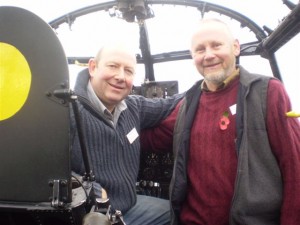
Skipper and flight engineer (but one generation on!) Rob Stevens, Son of Stevie Stevens in the pilots seat and Alastair Taylor son of Charlie Taylor in the flight engineers position. The bonds between crew members passed down through the generations! Photo taken on a visit to the East Kirkby Aviation Heritage Centre, Lincs.
